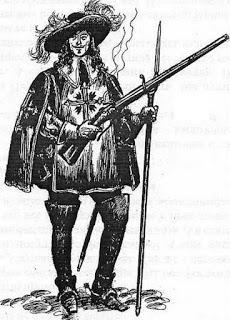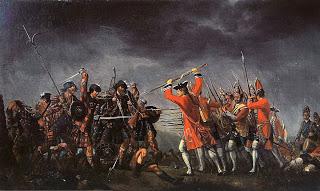 Quick, what do you think of when you hear the word musketeer?
Quick, what do you think of when you hear the word musketeer?A musketeer, from the French mousquetaire, was a type of soldier equipped with a musket. Musketeers were an important part of early modern armies, particularly in Europe and the west, as they normally made the majority of their infantry. The musketeer was a precursor to the rifleman. Muskets were replaced by rifles in most western armies during the mid-1850s.But most people think of Alexandre Dumas' The Three Musketeers and loads of swordplay. That's because The musket, though the prime weapon of the French Musketeers, was a cumbersome firearm to load and fire, as were other firearms of the time. That meant that a good rapier was a necessary second weapon that no musketeer was likely ever without. That meant the musketeers were also a skilled swordsmen.
The French National Army museum describes musketeers as:
In 1622, Louis XIII, at that time at war against the Protestants, detached the 50 soldiers armed with carbines from the companies of his guard’s lighthorse cavalry to form an independent unit. These soldiers were armed with a musket, a heavy weapon that could only be used on foot, but they were still cavalry who moved around on horseback. Called Musketeers of the Guard, a military branch of the Maison du Roi, they wore the famous blue tabard decorated with the cross and Fleurdelys, the symbol showing that they belonged to the King’s Household. The character of the musketeer mounted footsoldiers made very varied missions a possibility: escorting the royal retinue, policing operations and maintaining order but, above all, they were in the first line of the royal troops when it meant relieving a town under siege. In 1693, Louis XIV ceased to go to war and, from then on, the companies only took part in special cases. This period marked the end of the musketeers’ golden age, when they served in the last campaigns of Louis XIV but were rarely seen on the battlefield during his successor’s reign. During the eighteenth century, their mission mainly consisted in a guard and prestige service to the king. They were exposed to enemy fire one last time during the War of the Austrian Succession (1740–48). In 1775, the two companies were disbanded for budgetary reasons. Formed again briefly under the Restoration, they were definitely disbanded in 1815.
 Calling the French soldiers "musketeers" is a bit of a misnomer since they were more cavalry than infantry, but pole weapons were still being used in combat well into the 18th Century. The Jacobite forces used claymores when storming the British in the '45 rebellion. Likewise, French and Indian troops used tomahawks and other hand held weapons during frontier battles of the Conquest. Don't forget that bayonet is kin to the pole weapons where the firearm became a pole weapon.
Calling the French soldiers "musketeers" is a bit of a misnomer since they were more cavalry than infantry, but pole weapons were still being used in combat well into the 18th Century. The Jacobite forces used claymores when storming the British in the '45 rebellion. Likewise, French and Indian troops used tomahawks and other hand held weapons during frontier battles of the Conquest. Don't forget that bayonet is kin to the pole weapons where the firearm became a pole weapon.See also:
- Why were the Three Musketeers called musketeers when they spent all their time using swords?
- Musee de l'Armee Invalides: Mousquetaire!
- Alexandre Dumas (author): Why were the three musketeers called musketeers if they didn't shoot muskets?
- Rene Chartrand, French Musketeer 1622-1775, Osprey Warrior #168 ISBN 978-78096-861-2
